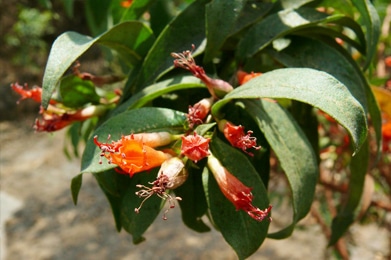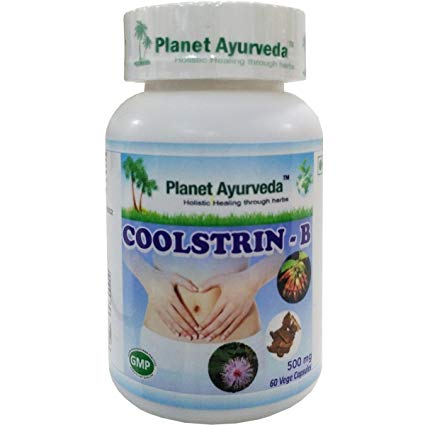Dhataki (Woodfordia fruticosa / Woodfordia floribunda Salisb) – Properties, Benefits & Dosage

Description of Plant
Dhataki is deciduous shrub with numerous fluted branches. This shrub has spreading branches reaching height up to 5-12mt. Branches of this shrub are long and multi spreading and stem is fluted and long. Bark of the shrub is smooth and reddish brown in color with very thin and small fibrous stripes. Leaves are about 5-9cm long, oblong or ovate and lanceolate. This shrub bears numerous flowers that are bright red in color. Small flowers of this herb grow singly or in groups along the twigs and branches. Every flower of this herb, borne a tiny stem, slender tube, curved and greenish base. Fruits are capsules about 1cm long, ellipsoid and membranous and it contains very minute, brown colored smooth seeds. Shrub is overloaded with bright red flowers in the month of February to April and its leaves shed off and new leaves appear. Its fruits appear from April to June.
General Information
Fire-flame bush, Shinajitea and Woodfordia all are common names of Dhataki. In Ayurveda this herb is used for various medicinal properties mentioned in Sanskrit scripture. Acharya charka consider this herb in “asava yoni”. Flowers are astringent and analgesics and used for preparing various medicines in ayurvedic medicine system. In ayurvedic scriptures this herb possesses various properties like fertility agent (garbhasthapaka), anti-diarrheal (controls atisara and pravahikakara), erysipelas (visarpa), poisoning (visha) and menstrual disorders (pradara).
Leaves and twigs of this plant produce a yellow dye that is used for printing. Petals of this plant yield a red colored dye. Dried extract of this herb is extracted by five different solvents that are water, methanol, ethanol, chloroform and ether. Methonolic extract of this herb is very effective against bacterial infections for both gram positive and gram negative bacteria.
Bark of the tree is pungent, acrid, cooling and uterine sedative. It is used for treating various disorders like leprosy, erysipelas, thirst, dysentery and various diseases of blood. This herb is not only used to ferment asav and arishta, but its flowers are also added for color and taste.
Main chemical compound available in the flowers of dhataki are tannins and cyaniding, diglucoside, octacosanol and beta-sitosterol are isolated from leaves. Leaves are rich in ellagic acid, polystachoside, pelargonidin-3 and 5-diglucoside. Dhataki also contains woodfordins A, B, C, D, E and F, trimeric hydrolysable tannins and tetrameric hydrolysable tannins. Other chemical compounds available in this herb are lupeol, betulin, betulinic acid, urosolic acid, sisterol and olealonic acid.
Habitat
Dhataki is medicinal herb of ayurvedic medicine system and it is native to Asia and Africa. In India and it is abundantly distributed throughout north India, to an ascending altitude of 1500mt. Mostly it is available in waste lands and open grasslands but it is also cultivated in gardens during the summer months. It is also available in Madagascar, Pakistan, Ceylon, Nepal, Bhutan, Myanmar, Indonesia and china. In India plant of woodfordia is distributed in Arunachal Pradesh, Mizoram and West Bengal.
Classification
- Kingdom – Plantae
- Order – Myrtales
- Genus – Woodfordia
- Species – floribunda Salisb
Names
- Hindi name – Ban-mahendi, Dhai, Dhati, Dhatki, Dhatri, Dhaura
- Botanical name – Woodfordia fruticosa
- Sanskrit name – Agnijwala
- Kannada name – Bela, Taamra pushpin, Daathakee kusumka
- Malayalam name – Tamarpushi, Tatire, Tatiripushpi
- Tamil name – Dhathari-jagri, Dhattari
- Telugu name – Dhaarhupushpika, Dhaathaki
- Tibetan name – Dha-ta-ke, Me-togda tak ki
- Urdu name – Gul dhawa
- Gujarati name – Dhaavadi
- Bengali name – Dhai, Dawai, Dhai phul
- Marathi name – Dhalas, Dhayati, Dhadva
- Punjabi name – Dhavi
- Farsi name – Dhaava
- Oriya name – Dhobo, Jaliko, Harwari
- Bihar name – Dhai, Dawai
- Jammu and Kashmir name – Thwai
- Nepali name – Dhangera
Ayurvedic Properties
| Hindi / Sanskrit | English | ||
| Rasa | Kashaya | Taste | Astringent |
| Guna | Ruksha, Laghu | Physical Property | Light, Dry |
| Virya | Sheeta | Potency | Cold |
| Vipaka | Katu | Metabolic Property (After Digestion) | Pungent |
Effects on Doshas
It balances Pitta and Kapha dosha.
| Charak Samhita | Sushrut Samhita | Vagbhata |
|
|
|
Ancient Verse about Woodfordia Fruticosa

It states that dhataki, dhatupushpi, tamrpushpi, kunjara, subhiksha, bahupuspi and vahnijwala all are synonyms of woodfordia. It is pungent and astringent in taste with cold potency causes delirium in higher dose and this herb is very light in nature. It is used in treating thirst, diarrhea and dysentery, bleeding disorders, poisoning, worm infestation and herpes.
Practical uses of Woodfordia Fruticosa
- Dhataki is very beneficial herb to cure range of vast diseases, it is used to cure diarrhea, piles and dysentery because it is a powerful astringent.
- Dhataki flower applied externally to relieve burning sensation of skin. Flowers are sprinkled over wounds and ulcers for quick healing and to stop discharge and granulation. For the local burns on body dhataki flowers are applied along with coconut oil to relieve burns.
- Flowers of this herb are immune modulatory and herb is also used to boost up immunity and overall body health.
- Decoction of dhataki flowers are used for treating vaginal prolapse and anal prolapse and also used for gargles to cure dental disorders. Flower awleha is used to reduce menstrual pain and it is also used to cure leucorrhoea.
- Flowers and roots are very effective in curing rheumatism, lumbar and rib fractures, and foot and mouth diseases.
- Juice of fresh flowers are applied externally to reduce headache caused by pitta dosha.
- In diabetic patients decoction of flowers are used to reduce thirst and other mouth related disorders.
- Being a mutra-viranjniye herb it is used to restore normal color of the urine in diabetic patients.
- It is also used in the treatment of fever that is caused due to pitta dosha.
- Dhataki flowers are used for the victims who are addicted to opium and suffering with diarrhea.
- Dried flowers are very beneficial for overall heart health and used to treat various heart related disorders.
- It is used to pacify pitta and kapha dosha.
Part used
- Leaves
- Fruits
- Flower
- Gum
Dosage
- Powder – 3-6gm
Ayurvedic Products from Woodfordia Fruticosa
Coolstrin-B Capsules
- The product is the great one to manage Ulcerative colitis.
- As the name suggests, the product has cooling effect on our body.
- It balances the aggravated pitta dosha in the natural way.
- The unique blend of herbs in this product will offer relief from all kinds of digestive disorders as well.
- The product is enriched with nutritional herbs and hence helps to gain weight also.
- The product is helpful in stomach related problems.
- It is effective in healing of the intestines.





2 thoughts on “Dhataki / Woodfordia fruticosa / Woodfordia floribunda Salisb”